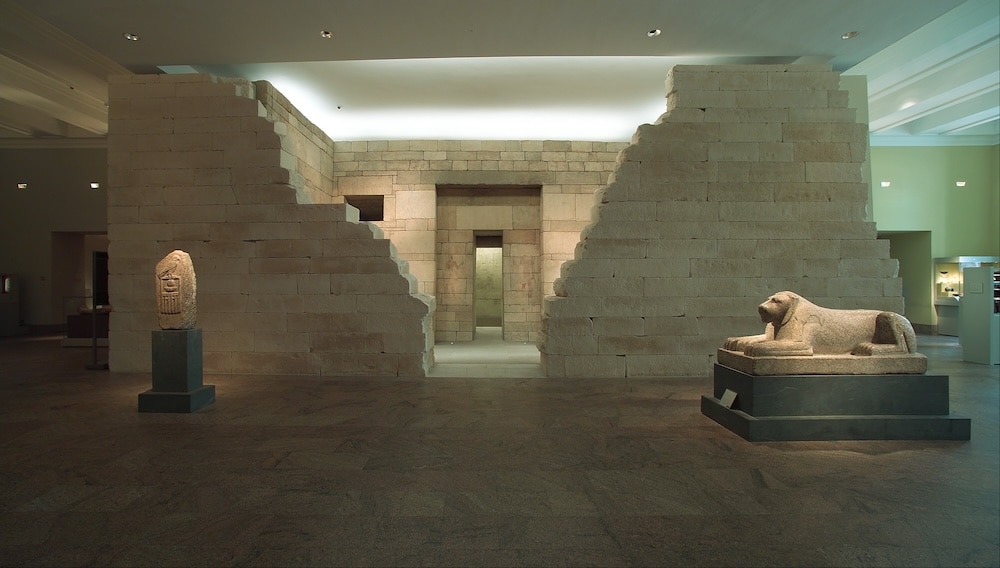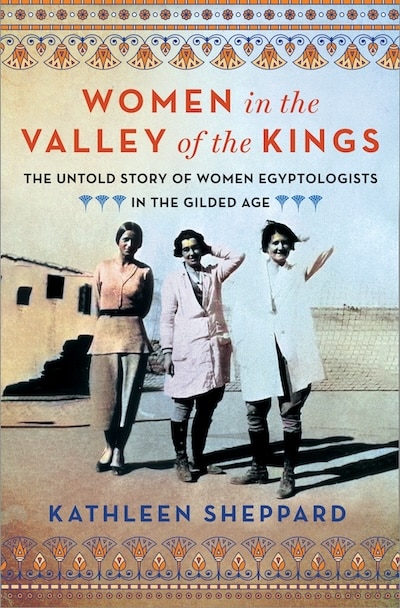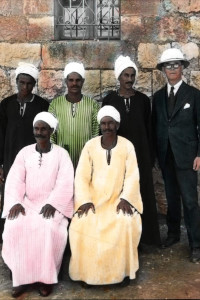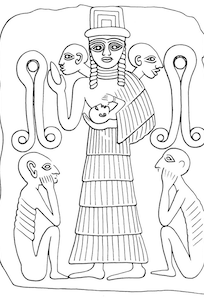
Not a Friend of ASOR yet? Sign up here to receive ANE Today in your inbox weekly!

July 2024
Vol. 12, No. 7
Crucial Labor: The Overlooked Contributions of Women in Western Egyptology
By Kathleen Sheppard
Women did much of the work that Western Egyptology has depended on for centuries. Often, the history of Western Egyptology foregrounds the work that men have done, starting with Napoleon’s invasion in 1798. The mostly male- and excavation-focused narrative isn’t necessarily wrong, it’s just that it leaves out a large part of the story.
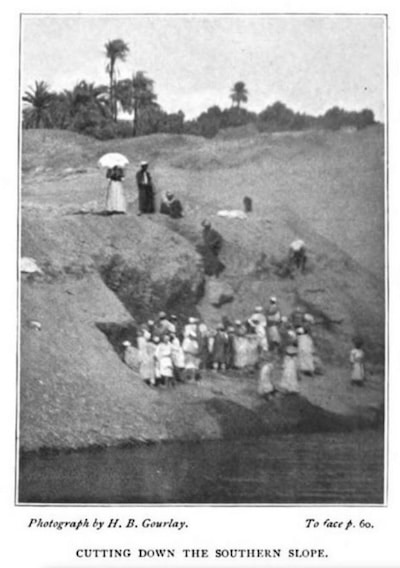
Excavations at the Temple of Mut in Karnak, c. 1897 (Public domain).
Already in the early nineteenth century, women — both Europeans and Americans — who had long been travel companions of their husbands, fathers, brothers, or sons, would begin traveling on their own or with other women. These women were inspiring all sorts of Western travelers to visit Egypt. Some of the women who began as tourists wanted to know more about the ancient artifacts they were seeing, and they became writers, patrons, and Egyptologists themselves. Women were traveling, writing, excavating, and teaching — that is, they were doing crucial labor in the development of Egyptology in the Western world.
One of the earliest English visitors to Egypt was Sophia Lane Poole (1804–91) who, with her two sons, traveled to Egypt with her brother Edward William Lane in 1842. They lived there for seven years, and Poole began recording her experiences in the form of letters back home. Based on these letters, she published a book in 1846, The Englishwoman in Egypt: Letters from Cairo, which detailed what life was like for her as a Western woman in Cairo. It was also the first book to describe life for Egyptian women at that time, which was mostly untouched by Western influence. Her English perspective was often condescending, but she was writing to an audience of people just like her.
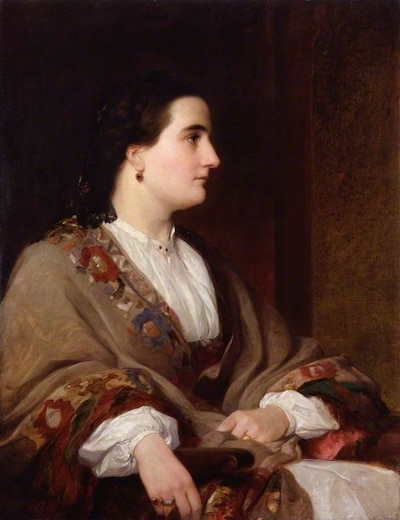
Lucie, Lady Duff Gordon, c. 1851 by Henry W. Phillips (Public domain).
Poole’s letters had a massive influence on the genre of travel writing and on the lives of other women, like Lucie, Lady Duff Gordon (1821–69). Duff Gordon, who had contracted tuberculosis probably in the 1850s, traveled to Egypt in 1862 to relieve her symptoms and to dry out her lungs. Over the next seven years, until her death, she wrote hundreds of letters home to her family, which were published in 1865 as Letters from Egypt, 1863-1865 and Last Letters from Egypt in 1875. Both books were best-sellers in the UK and the US. Neither Poole nor Duff Gordon wrote much about the antiquities they lived among — they simply weren’t that interested — but the accessibility of their writing and their experience in traveling in Egypt (and how to do it) inspired even more people to travel. And the women came in droves.

Maggie Benson (right) and Nettie Gourlay (left), 1906 (Public domain).
It wasn’t long before women travelers wanted to know more about the monuments of Egypt’s past. Soon they took on the roles of patron and excavator on archaeological sites, right as men were doing the same. Maggie Benson (1865–1916) and Nettie Gourlay (1863–1912) were the first women to receive official permission to excavate in Egypt. Both had traveled to Egypt seeking relief from various ailments, and both had been educated at universities in Britain. Gourlay had even been trained at University College, London, in the brand-new Egyptology department. The two were introduced in Luxor, and from 1895 to 1897 they excavated at the Temple of Mut in Karnak. Their best-selling Temple of Mut in Asher (1899) was the site report for the project, detailing everything from a daily work schedule to their finds each of the three seasons. Artifacts from the site went to the Egyptian Museum in Cairo as well as several museums across the UK; many of them are still on display. Their work continues to affect Western understandings of the temple complex itself and of the worship of Sekhmet in ancient Egypt.
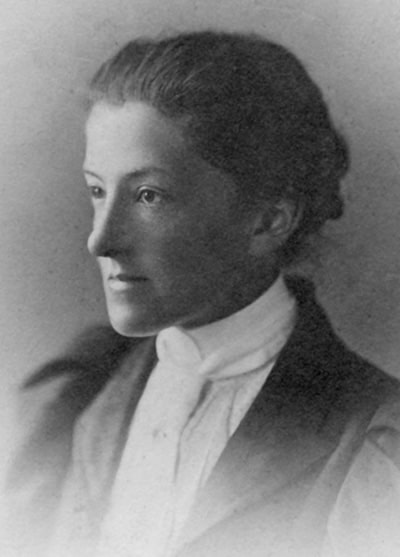
Kate Bradbury, March 1890 (Griffith Institute, CC BY-SA 4.0).
As more Western men and women came to Egypt to figure out what lay beneath the sands, even more women remained behind in institutional spaces as administrators, teachers, and museum curators. The Egypt Exploration Society (EES, founded as Egypt Exploration Fund in 1882) depended on women such as Emily Paterson (1861–1947), Kate Bradbury (1854–1902), and Mary Jonas (1874–1950). They were the secretaries whose job it was to manage field processes like permissions, reservations and pay, as well as tasks at home, like exhibitions, artifacts, and correspondence. The evidence they left behind was largely in these correspondence collections and in the relationships they built with the people they worked alongside. Intangible or difficult to trace, they tend to be the first ones forgotten, even though their names are within and throughout the stories. Paterson, as far as we know, doesn’t have an existing photograph. And yet, because these women were at their desks, day in and day out, these research centers survived and thrived through two world wars and several cultural and ideological shifts.
Mastaba tomb of Perneb, Metropolitan Museum of Art (Open Access).
Likewise, museums across the Western world depended on women to build and maintain their collections so that millions of people could visit, learn, and carry on their legacy. Caroline Ransom (1872–1952) didn’t want the usual heavy teaching load that came with being a woman in academia, so in 1910 she left her position as chair of the History of Art and Classical Archaeology at Bryn Mawr College. She moved to New York to be an assistant curator of Egyptian Art at the Metropolitan Museum of Art under Albert Lythgoe. As assistant curator for the next six years, on top of taking on Lythgoe’s work as curator while he was in the field for six to seven months of the year, Ransom accessioned thousands of objects and wrote and published several articles and at least two books. Her biggest project at the museum was unpacking, preserving, and rebuilding — brick by brick and indoors — the complete mastaba tomb of Perneb. From 1914–1916 this was her main task. Her book about the tomb, co-authored with Lythgoe, The Tomb of Perneb: With Illustrations (1916), explained to visitors not only the excavation of the tomb but also the historical meaning and impact of the tomb. The book was a best-seller, and the tomb still stands in the Egyptian wing of the museum, welcoming millions of visitors each year.
Even though these women in Egyptology toiled for decades to build the discipline, they have been ignored and gone largely unappreciated by historians. Just like their male counterparts, their contributions were profound and imperfect. Their labor should, however, be known, celebrated, and criticized along with the rest of Western Egyptology. Historians are just beginning to truly grapple with the impact women have made in Egyptology, so we must continue to tell their stories.
Kathleen Sheppard is Professor in the History and Political Science Department at Missouri S&T. Her book, Women in the Valley of the Kings: The Untold Story of Women Egyptologists in the Gilded Age, was published in July by St. Martin’s Press.
Want To Learn More?
Archaeological Laborers of 20th-Century Palestine
By Melissa Cradic
Who were the workers who carried out excavations in the “big dig” era of early 20th-century Palestine? A recent online exhibition by the Badè Museum brings these oft-overlooked archaeologists into the light. Read More
Gender in the Ancient Near East and Egypt
By Stephanie Budin
Sex and gender have become central topics of discussion in a wide variety of fields. What did the people of ancient Mesopotamia and Egypt think about these concepts? Read More
